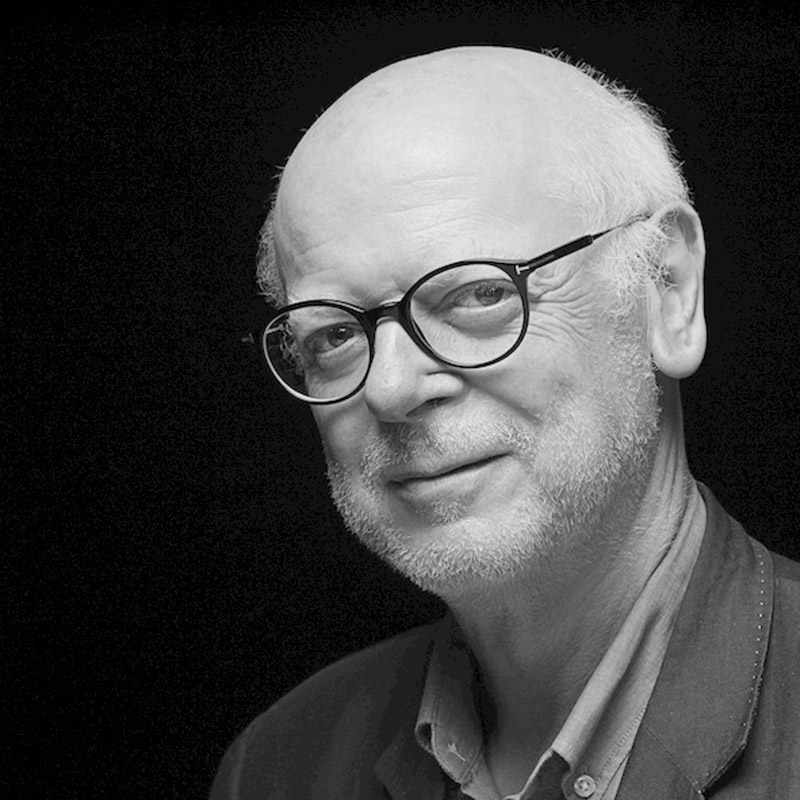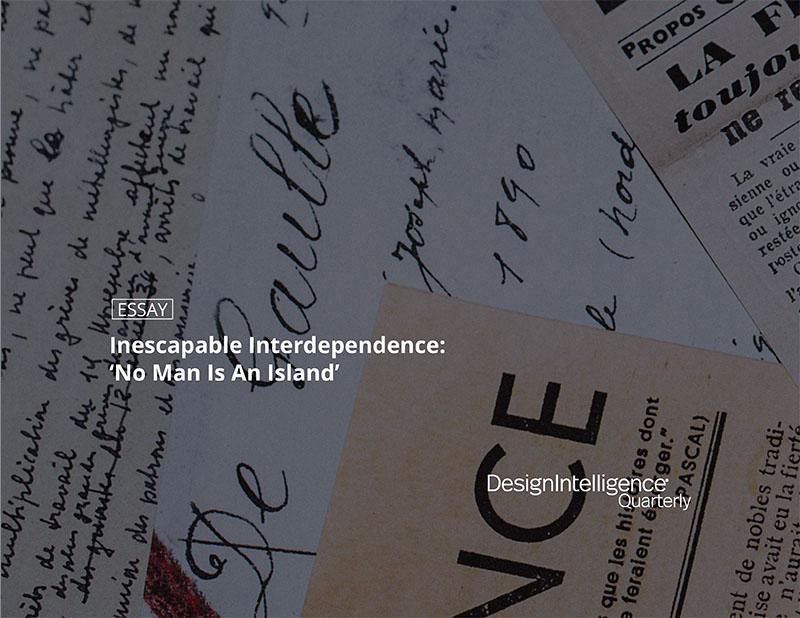Inescapable Interdependence: ‘No Man Is An Island’
by Paul Hyett
RIBA, Hon FAIA,
Vickery Hyett Architects, Founder—Partner
September 29, 2021
Re-examining the tenets of interpersonal responsibility
Reading
Someway into my first project design tutorial with Stephen Mullin I was taken aback when he asked, ‘What are you reading at present?’.
Reading?
I wasn’t reading anything and hadn’t since starting college. The reading list issued to Canterbury’s first year students had comprised, almost to a book, a grimly dull account of architectural history. Only Le Corbusier’s 1927 manifesto ‘Vers Une Architecture’ (accessible to us courtesy of Frederick Etchells’ translation as ‘Towards a New Architecture’) offered any vision of hope and change. Why should we read? As first year ‘architects’ we were about the future not the past, about talking and drawing, not reading or writing.
Mullin (who thrust Jane Jacob’s ‘The Death and Life of Great American Cities’ into my hand), and the Architectural Association (AA), changed all that.
Having mounted a futile challenge against its staid curriculum, I had failed Canterbury’s first year, a failure that was to be hugely beneficial to me. Rather than re-sit, I managed to transfer to the AA where I was immediately exposed to wide ranging and conflicting views on architectures and architectural ideas past, present and future, all delivered through exposure to a rich combination of provocative lectures, lively seminars, and challenging ‘crits’. Together they formed part of a wider ‘discussion’ that found expression through articles, journals, books and (even then) videos as the antecedents of today’s podcasts.

Left: Le Corbusier’s 1927 manifesto 'Towards a New Architecture.' Author image.
Right: 'The American City,' edited by medical sociologist Anselm Strauss. Author image.
Such a pedagogy is ultimately based on dependency - each new generation’s reliance (at least as a point of departure) on the collective work, thought and teaching of previous generations. In addition, this process often leads to the ongoing development and realisation of ambitions, agendas, and manifestos of one generation through the work of the next. Thus the symbiotic notion of interdependency creeps in.
Fascinating fact: take a late Stone Age child from around 5,000 years back. Sophisticated languages were well developed by then and various systems of characters representing linguistic sounds were emerging as ‘writing’ to replace more primitive pictorial communications. Fast-forward that child to today: how far could she advance through our educational system? Answer: all the way. Yes, the human brain had the power, way back in the Stone Age, to receive, acquire and usefully apply all the knowledge and training expected of a youngster today. Nature and nurture permitting, and with appropriate opportunity and input, tertiary education and even a PhD would all be accessible for that Stone Age child.
A specialist in cognitive issues once explained to me that the human brain has evolved very little since the later Stone Age. In that respect, it can be described as a computer’s hard drive. What has changed is the software - what we ‘feed’ and how we ‘programme’ our brains for knowledge accumulation and operating systems. Scary stuff that aptly illustrates our reliance on previous generations to pass down knowledge, theory and training. This is about dependency: a one-way transmission which each subsequent generation receives from its predecessors.
Now consider the pressing agenda of global climate change. The well-being - even survival - of future generations has become increasingly dependent on the commitment and performance of its antecedents’ responsible conduct and regulation. But it is for the sake of our children’s children, not ourselves, that we seek to ensure that our planet is preserved and respected. This is dependency rather than interdependency. It runs principally upstream. Only concern, responsibility and hope run downstream: we want future generations to adopt and improve on our work against this agenda for their sake, not ours. But our own well-being doesn’t depend on their commitment or success. In contrast, the essential viability of our planet as a host environment is contingent on our efforts. In that respect, future generations depend upon us.
In the ecological agenda, interdependence prevails, but it is mostly grounded within concurrent time frames. Each nation depends on the parallel commitment and performance of its sister nations to deliver responsible policies that will ‘save’ our planet. As my friend Paul Finch says, interdependence is fundamentally reliant upon collaboration.
Turning to the world of construction, at its crudest and simplest level, interdependence manifests itself as a weakness. The architect needs the structural engineer, the facades engineer and the services consultant to do the detailed design and calculations as these specialties fall outside our skillsets. In contrast, unique rich outcomes often emerge from collaborations between disciplines. A good example would be Schlaich Bergermann which, as structural engineer specialising in compression ring systems, has given architectural expression to a range of beautiful roofs for a variety of stadiums. In contrast, the collaboration of Jorn Utzon and Ove Arup for the Sydney Opera House involved the engineering of a pre-conceived architectural form, but the interdependency of the architectural and engineering disciplines is obvious. The jury is out on Wembley Stadium: was that infamous arch initially proposed by the structural engineers (Mott MacDonald) as an engineering solution designed to carry the eccentric and dynamic loads of a ‘moving’ roof, or by the architect as an eye-catching architectural feature and landmark? Either way, the interdependence of the respective professional disciplines is evident.

The Arch of Wembley Stadium. Vickery Hyett.
The architectural profession also sees regular interdependencies between individuals within firms. Some of these collaborations are expressed in the very name of the practices. In the UK, Powell and Moya of St John’s College fame and Chamberlin Powell and Bon as architects of the Barbican are good recent examples. The current RIBA President’s firm Alford, Hall, Monahan and Morris (AHMM) is another. In the latter case the partners met and worked together at college then developed interdependent careers within what has now become one of Britain’s largest and most respected practices.
Other UK firms, such as Terry Farrell and Norman Foster, have been more discrete about internal operational (inter)dependencies. Inevitably, despite the relatively lower profiles that exist within such organisations, there is usually a powerful support figure or figures) who are critically important enablers of interdependent relationships. Such interdependencies also exist across the ranks, and up and down any firm of size within the construction industry: star-designers need the technical and delivery teams which, in turn, need the stars.
Following graduation, my ‘education’ continued, courtesy of a recommendation by Stephen Mullin, at the office of avant-garde architect Cedric Price. Just a few weeks into that job Cedric asked me what I was reading. Nothing, of course: I had finished college. Marching over to his bookshelf he invited me to choose two books. I selected Peter Hall’s ‘London 2000’ (a self-confessed 1963 attempt to ‘uncover the problems that lie before us in reshaping London’) and Reyner Banham’s ‘Theory and Design in the First Machine Age’. My new boss then told me that he only ever lent one book at a time, and handed me Banham, carefully making a diary note for a seminar some three weeks later at which I would present him and the office with my thoughts on the read.
Fast forward half a century to May 2021. I am again in Stephen and Sue Mullin’s flat for lunch. Mid-conversation, Stephen wandered to his bookshelf and pulled down a battered copy of ‘The American City’ - a 1968 collection of some ninety short essays dating as far back as 1900, as edited by Anselm Strauss, a medical sociologist. Per chance, this extraordinary book sets out, with stunning clarity, the case for interdependence. Here, we find essays as diverse as ‘Why the Police Are Not More Effective’; ‘Keeping the Peace in Skid Row’; ‘Symbolism, Space, and the Upper Class’ (respectively penned by a Chief of Police and two sociologists) and ‘The City Beautiful: Trees, Parks, And Other Open Spaces’ by the great landscape architect Frederick Olmsted of New York’s Central Park fame.
This extraordinary book is structured under seventeen sub-sections against sub-headings such as ‘Perils of the Great City’, ‘Poverty and its Solutions’, ‘Democracy, Politics, and Municipal Reform’, ‘Order and Disorder in the City’, ‘Suburbia’ and ‘City Planning. But it is the very diversity of this structuring and the collection of essays that lie within each sub-section that so aptly illustrate the essential interdependence of the disciplines and agendas that must be satisfied. Their often-conflicting agendas must be reconciled across delivery, operation, and maintenance if we are to see success in any work that the building professions, from planners and urban designers to architects and engineers, carry out.

Other American essay collections such as Gates and Stout’s ‘The City Reader’ (1996) brought together diverse themes through brilliant essays by the likes of Kevin Lynch, William Whyte, Christopher Alexander, Delores Haydon, Lewis Mumford, Michael Young and Peter Wilmott, Ebenezer Howard, Raymond Unwin and Patrick Geddes. Again these were organised within discrete subject areas as diverse as Urban Form; Society and Culture; Politics, Governance and Economics; Urban Planning and the Future of the City.
Stark evidence of the interdependency so well illustrated in these publications was evident on my journey to the Mullin’s home as I travelled along Islington’s Essex Road. Here, to the ultimate shame of that London Borough, the larger parts of one of the most interesting municipal housing projects of the Post-War era have recently been demolished. Designed by the distinguished architects Darbourne and Darke, Marquess Road, a dense low-rise scheme ranging between three and six stories, offered a deliberate alternative to 1960s tower blocks, taking the form of a series of streets and alleys of predominantly single-family houses with gardens set around green spaces and elevated courtyards.
The scheme was initially applauded as an exemplar of good housing design by the Department of the Environment. But soon after its opening, the project gained a fearsome reputation as an area of misdemeanour and occasional serious felonies. Police reports claimed that the tightly compact intricate design lent itself to crime and problems became so acute that the Council ultimately decided to demolish 463 of the homes, replacing them with a dreary and substantially inferior, albeit simpler development.
Such a ‘failure’ was all the more surprising when set against Darbourne and Darke’s earlier, phenomenal and enduringly successful Lillington Gardens project, a similar design of some 540 flats housing some 2000 people in the London’s Borough of Westminster. Completed in 1972, this project remains popular with residents and critics to this day. Though slightly more complex in its design, Marquess Road had adopted a similar design approach, but the two Boroughs carried differing challenges and problems. The contrasting fates of the schemes highlights the interdependency of issues such as tenure, tenant selection and home allocation, maintenance, management, policing and, dare I suggest, education, social behaviours, and citizenship. Get any one of these wrong, or any two or more out of kilter, and disaster looms. In this respect, the interdependency of the enormous range of professional disciplines involved in programming and brief forming; concept and design development; master planning, urban design, architecture and landscape; interior planning; security, wayfinding and circulation; maintenance and management; tenure and allocations; and policing, complaints and enforcement, is highlighted in the sharpest and starkest of fashions.
All this requires an appreciation of the broad agendas that must inform intelligent design. In this respect, we must be ever cognisant in place and city making that the way we work, and what we work for, demands increasing operational interdependence across an ever-widening spectrum of disciplines. Never has this been truer than now as we face the daunting challenge of designing tomorrow’s eco-sustainable world. As John Donne wrote in his famous poem of 1624, later delivered to great effect as a sermon: ‘No man is an island’.
‘….every man is a piece of the continent, a part of the main;
if a clod be washed away by the Sea, Europe is the lesse,
as well as if a Promontorie were, as well as if a Manor of thy friends
or of thine owne were; any man’s death diminishes me,
because I am involved in Mankinde;
And therefore never send to know for whom the bell tolls;
It tolls for thee’.
We can only succeed if we collaborate across the widest of disciplines and co-operate across national boundaries. We live in a finite environment. We are interdependent, one on all. These realizations frame an awesome and awful truth: ultimately, real progress against the eco-sustainability agenda demands the absolute unqualified commitment of China and the USA. If its leadership so directs, the Chinese people have the subservient nature and discipline to buckle down and deliver. But even if the American leadership was to comply, its people seem unable to break the yoke of their passionate beliefs in freedom. Many of those beliefs are immature and ill-defined: freedom to plunder resources? freedom to impose havoc on future generations? ‘America First’ in every context and against every agenda?
The survival of humankind now hangs precariously in the balance at this nanosecond to midnight. The world needs America’s participation, leadership and spirit more than ever before. We also need America to again recognise that upon this planet, we are inescapably interdependent.
Paul Hyett is a founding principal of Vickery-Hyett in the U.K., past president of the Royal Institute of British Architects and a regular contributor to DesignIntelligence.


